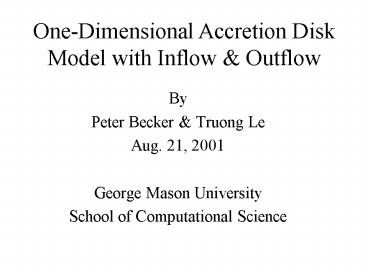OneDimensional Accretion Disk Model with Inflow - PowerPoint PPT Presentation
1 / 19
Title:
OneDimensional Accretion Disk Model with Inflow
Description:
The thin accretion disk models describes a cooling-dominated flow in which the ... model provides the picture of how gases flow near the vicinity of a black hole ... – PowerPoint PPT presentation
Number of Views:77
Avg rating:3.0/5.0
Title: OneDimensional Accretion Disk Model with Inflow
1
One-Dimensional Accretion Disk Model with Inflow
Outflow
- By
- Peter Becker Truong Le
- Aug. 21, 2001
- George Mason University
- School of Computational Science
2
Accretion Disk Background
- The thin accretion disk models describes a
cooling-dominated flow in which the viscous
heating of the gas is balanced by local radiative
cooling. - Thin accretion disks model first developed by
Shakura Sunyaev (1973), Novikov Thorne (1973) - Global models of thin accretion disk developed by
Paczynski Bisnovatyi-Kogan (1981), Muchotrzeb
Paczynski (1992)
3
Accretion Disk Background
- The thin accretion disk models describes an
advection-dominated flow in which the radiative
cooling is very inefficient and most of the
dissipated energy is advected into the black
hole. - Global models Advection-Dominated Accretion
Flows developed by Begelman (1978), Begelman
Meier (1982) and Narayan, Kato Honma (1997).
4
Accretion Disk Background
- The thin accretion disk models describes an
advection-dominated flow in which the radiative
cooling is very inefficient and most of the
dissipated energy is advected into the black hole
and some escape to infinity. - Global models Advection-Dominated Inflow-Outflow
Solution (ADIOS) developed by Blandford
Begelman (1999). - Global models Relativistic Advection-Dominated
Inflow-Outflow Solutions (RADIOS) modified by
Becker, Subrammanian Kazanas (2001)
5
Accretion Disk Descriptions
- Suppose matter is going around a mass M in a
nearly circular orbit of radius r. - Ballancing gravitational force against
centrifugal force, we find the angular velocity
to be
6
Accretion Disk Descriptions
- Now consider a gaseous disk varies in accordance
with the angular description W. - Such a variation of angular velocity would imply
the existence of velocity shear within the disk - Due to the action of viscosity, we then expect
angular momentum to be transferred from the
faster-moving inner regions of the disk to the
slower-moving outer regions. - As the material in an inner layer loses angular
momentum, it moves inward in a spiral path.
7
Accretion Disk Descriptions
- Hence it is viscosity which determines the rate
of radial inflow of matter and therefore the rate
at which the gravitational potential energy is
converted into other forms. - If the gas had no viscosity, then the material in
the disk would keep on going in circular orbits
and there would be no release of gravitational
energy after the formation of the disk.
8
Accretion Disk Flows
- Since the gas will be radially accelerated toward
the black hole, undergoing a transition from
subsonic to supersonic speed, a full description
of the flow necessitates that the pressure and
inertial terms be included in the radial equation
motion, the viscosity be included in the angular
equation of motion, and the energy transport by
advection be included in the energy equation. - Also, because we are interested in the outflow
solution as well as the inflow solution, we need
to include the outflow of mass, angular momentum
and energy in the equations of motion.
9
4 Conservation Equations
- Mass Conservation
- Angular Momentum Conservation
10
4 Conservation Equations
- Radial Momentum Conservation
11
4 Conservation Equations
- Energy Conservation
12
Narayan et al. (1997) Solution
- To obtain Narayan et al.(1997) solution, we
assume that there is no outflow by taking the
escaping times to infinity. - Once we did that our equations confirm their
equations of motion. - At this point, we have confirmed Narayan et
al.(1997) numerical results by solving these 4
equations in a time steady state for (v,P,W,r).
13
Inner/Sonic Point/Outer Boundary Conditions
- Inner Boundary Conditions
- Entropy parameter (K)
- Specific angular momentum (l)
14
Inner Point Boundary Conditions
- Energy flow per unit mass
15
Sonic Point Boundary Conditions
- Solving the differential velocity dv/dr we
obtain two critical point conditions when the
vanishing of both N and D occurs at the sonic
point
16
Outer Point Boundary Conditions
- Narayan et al.(1997) outer boundary conditions
17
Numerical Solution
- Case 1 a.1, gg1.5, J2.6, E-1.01103x10-7,
K00.00734, rC6.132, rgC2.001
18
Numerical Solution
- Case 2 a.001, gg1.5, J3.767 ,
E-7.03703x10-7, K00.0000708, rC4.22, rgC2.001
19
Conclusion
- First, we have shown that our numerical solutions
are the same as Narayan et al. (1997) - Second, the Advection-Dominated Accretion Flows
(ADAF) model provides the picture of how gases
flow near the vicinity of a black hole - Third, now that we have understood some what
about the ADAF inflow model, we could now
incorporate the outflow part to the model and
hope to understand the outflow characteristic of
many AGN objects which contain jet.































